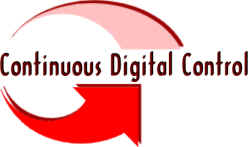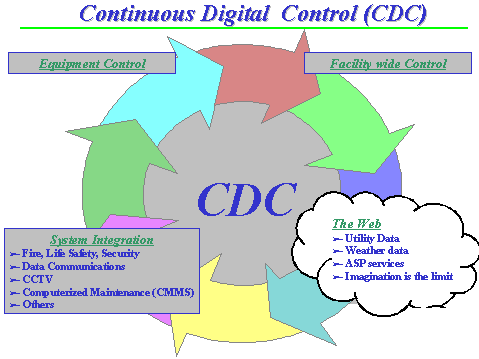
AutomatedBuildings.com
|
[an error occurred while processing this directive] |

John J.
"Jack" Mc Gowan, CEM
Contributing Editor
The term Direct Digital Control no longer describes the industry's goals; rather it wants Continuous Digital Control.
The genesis of this article was the recognition that DDC has transcended the direct control of individual pieces of equipment, and is now more about the integration of that equipment into a global system. Some in the industry have coined the term Enterprise Energy Management to focus on this larger perspective for automation and control. This is not to say that equipment control itself is no longer important, rather the point is that DDC effectively accomplishes that task, but the value that owners are seeking today goes beyond the finite building envelope. Further that the control of that equipment can be enhanced with access to data from a much larger world. The industry now demands that value goes beyond the microcosm within 4 walls, and that systems deliver optimized comfort, control and operations cost. What makes this control continuous is that individual equipment sequences can incorporate the full spectrum of information including; temperatures and pressures directly impacted by the process and data from outside the building, such as real time electric rates.

This article will focus on one key piece of hardware that makes this functionality possible. System Integrators are responding to the demand for anytime, anywhere access to systems and for access to more that what is happening in the building, and that can encompass anything from weather data to data from Internet-enabled meters and the spot price of natural gas. The term Direct Digital Control therefore no longer describes the industry's goals; rather it wants Continuous Digital Control. Much like continuous improvement in quality circles this means an ongoing pursuit toward the integration of more and more digital intelligence into the control of both individual buildings and campuses. As a result there is a completely new architecture that is evolving, and implementation of system that apply this approach is spawning a CDC industry. The CDC architecture actually encompasses a new component that is becoming more and more common with DDC systems, and it is one that you may not even have realized existed. With the advent of system integration and the commonality of the Web Browser as a "front end", more and more systems are integrating servers.
[an error occurred while processing this directive]What is a server? A server is a centralized microprocessor that provides services to "users", which may be workstations or DDC controllers. Servers offer a wide variety of services from interface through devices such as routers which connect nodes, or devices, of like networks and gateways which do protocol conversions. In the new world servers that provide applications are of particular interest, and at the simplest level these servers are like those on an office LAN that allow file and printer sharing. Well we are all familiar with servers in various local area networks, but what does that have to do with building controls? If there is one thing that the trend toward data communication standards in the energy industry has taught us, it is that DDC systems, by the nature of distributed processing, require networking. At one time the author used to call these local area control networks, but the fact is that they are simply networks like many other LANs. The implementation of a LAN allows for multiple computers, whether they are workstations or DDC devices, to share information over a common medium or wire. The server comes in to play if the devices on that network need to share application software, large volumes of information or if they require other external processing. All this may be interesting, but you are still wondering why a server is needed for a DDC system? Well in many respects there have always been servers on DDC networks.
In the really old days DDC systems were called Energy Management or Building Automation Systems and they always integrated a server. These servers were mini computers that were sometimes called a Host, and they held all the system intelligence from control logic to schedules and alarms. As Distributed or "Direct Digital" Control evolved, networking became more important and all the central functions were spread throughout the network. What no one could quite foresee however, was the level of integration that would develop. The World Wide Web was in its infancy when ASHRAE began work on the BACnet® Standard. All of the technology that has accompanied the Internet age has offered significant opportunity to expand and enhance DDC. Every vendor of DDC equipment that the author visited at ASHRAE had a Web browser interface and several had various approaches for wireless interface including menu driven cell phone interrogation of systems. To accomplish these tasks in many cases requires, guess what?, a server. In the final analysis what is so exciting for our industry is that a tremendous array of off-the-shelf technology is now available to improve the application of control systems. Do you want to have a hand-held wireless Web-appliance for anywhere anytime access to your building? Of course you do! Yet it would be cost prohibitive, not to mention a waste of time, to create such a device for custom application to DDC systems. Especially when cell phones are inexpensive, readily available and already exist. Yet as all sorts of Web-enabled technology begins to converge on our industry the requirement arises for a way to create an interface. This is not a difficult problem however, because there is already a universal device that meets this requirement, the Server. Again a server is nothing more than a dedicated computer and it becomes the ultimate Web-Appliance to integrate everything from Cell phones and light weight client software such as Netscape Navigator to Computerized Maintenance Management Systems into our DDC systems.
Therefore servers are now becoming common to allow for everything from Web browser interface to integration of wireless devices. These wireless devices are compatible with many standards including WAP (Wireless Automation Protocol) and Blue Tooth to allow the systems to integrate the full power of every application available through the World Wide Web. In fact the industry does not realize it yet but there is a demand for this new term Continuous Digital Control. The term DDC was spawned by the drive for specialized control, the distribution of computer intelligence to the lowest common denominator, the direct application of digital control. What is happening today relies on that distributed intelligence for fine tuned building control, but the true innovation that we are striving for today is global in nature.
Continuous Digital Control entails the integration of all the discrete systems that were mentioned above, but more importantly it demands innovation in the way that these systems are combined. The true wonder of this process is that it allows for truly creative people to look at independent discrete systems that offer value, yet could be combined to bring a completely new benefit. Systems mentioned in the authors recent articles in the Automator and Energy User News, that allow real-time control sequence adaptation in buildings based upon email notices of changing electric rates are a great example of CDC. This is only the beginning, what about integrating streaming video into troubleshooting of HVAC maintenance to allow a third party many miles away to provide direct advice on repairs. This type of thing is already done everyday in surgical suites, but the technology already exists to migrate it to our industry. Think for a moment about projects you have currently underway and an equally or more creative concept is likely to spring to mind. So the server is here to stay as an element of control systems, but more importantly it is critical for the industry to demand of itself the application of a multitude of ways for servers to introduce new and useful information to CDC. Though the phrase may be somewhat tired, the concept of CDC demands "thinking outside the box", it demands that energy engineers embrace every form of new system and web-appliance imaginable to continuously improve our application of digital control.
[an error occurred while processing this directive]
[Click Banner To Learn More]
[Home Page] [The Automator] [About] [Subscribe ] [Contact Us]